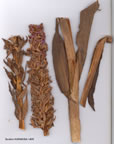| Orchidaceae |
 Dactylorhiza osmanica var. anatolica |
Dactylorhiza NECKER EX NEVSKI |
| D. osmanica (Kl.) So6, Nom. Nov. Gen. Dactylorhiza, Budapest 4 (1962). Plants 20-60(-80) cm. Stem solid or hollow, leafy. Leaves (4-)5-8(-10),
broadly lanceolate or lanceolate, (8-)10-15(-18) x 2-4(-5) cm, sometimes folded. Spike cylindrical, dense, 8-20(-30) cm. Bracts lanceolate, lower exceeding the purplish, rarely creamy-white flowers. Sepals and petals ovate-lanceolate, subobtuse; sepals 9-12 x 4-5 mm, petals slightly shorter. Labellum mostly entire, sometimes subentire, suborbicular, 7-10(-12) x 9-12(-15) mm,
with darker coloured interrupted loops and spots. Spur conical-acute, shorter than ovary, 5-8(-l 1) mm, 3-4 mm broad at base. 1. Plants 20-60 cm; stem solid (small plants) or slightly hollow, with 4-6 usually ± flat leaves; spike(5-)8-12 cm, dense; flowers purplish or rose-purplish, rarely white var. osmanica 1. Plants stout, very large, 60-100(-120) cm; stem hollow, with 8-10 usually . folded leaves; spike (12-)15-24(-30) cm, very dense; flowers dark purplish, sometimes creamy-white var. anatolica var. anatolica (Nelson) Renz & Taub. in Notes R.B.G. Edinb. 41:271 (1983). Syn: Orchis gigantea Siehe ex So6 in Feddes Rep. Sonderbeih. A, 2:229 (1933) pro syn., nom. and.; Dactylorhiza elata (Poiret) So6 subsp. anatolica Nelson in Taxon 28:593(1979)! Ic: Nelson, op. cit. t. 8, 9, 81 f. 59 (1976). Map 107. , Fl. 6-7. Marshy meadows, by springs and streams, 1000-1900 m. Type: Turkey [C5 Adana]: Cilicischer Taurus, Pozantı, Mitte Mai 1952. Blütenanalyse Nr. 26 (Hb. Nelson, STU!)". S. & C. Anatolia. B5 Kayseri: 30 km E. of Kayseri, nr Bünyan, 1200 m, Renz & Taub. 78.421 (flowers white)! B6 Maraş: 34.7 km from Elbistan to Göksün, 1380 m, Taub. 76.442! Sivas: nr Tuzla, Siehe (as O. gigantea Siehe in sched.)! B7 Erzincan/Tunceli: Pülümür pass, 1900 m, Renz & Taub. 78.452! C5 Adana: Pozanti, Siehe 1896:384! C6 Adana: Karakilise, or Saimbeyli, 10 vii 1906, B. Post! Endemic. Ir.-Tur. element. A very conspicuous taxon, usually associated with var. osmanica in larger populations in marshes above 1000 m. Its robust habit with dark purplish (rarely creamy-white) flowers resembles the W.Mediterranean and Atlantic taxon D. elata (Poiret) So6 subsp. sesqupedalis (Willd.) So6. On account of this striking resemblance, Neison related the Anatolian plants to D. elata. Distribution of species: endemic. |